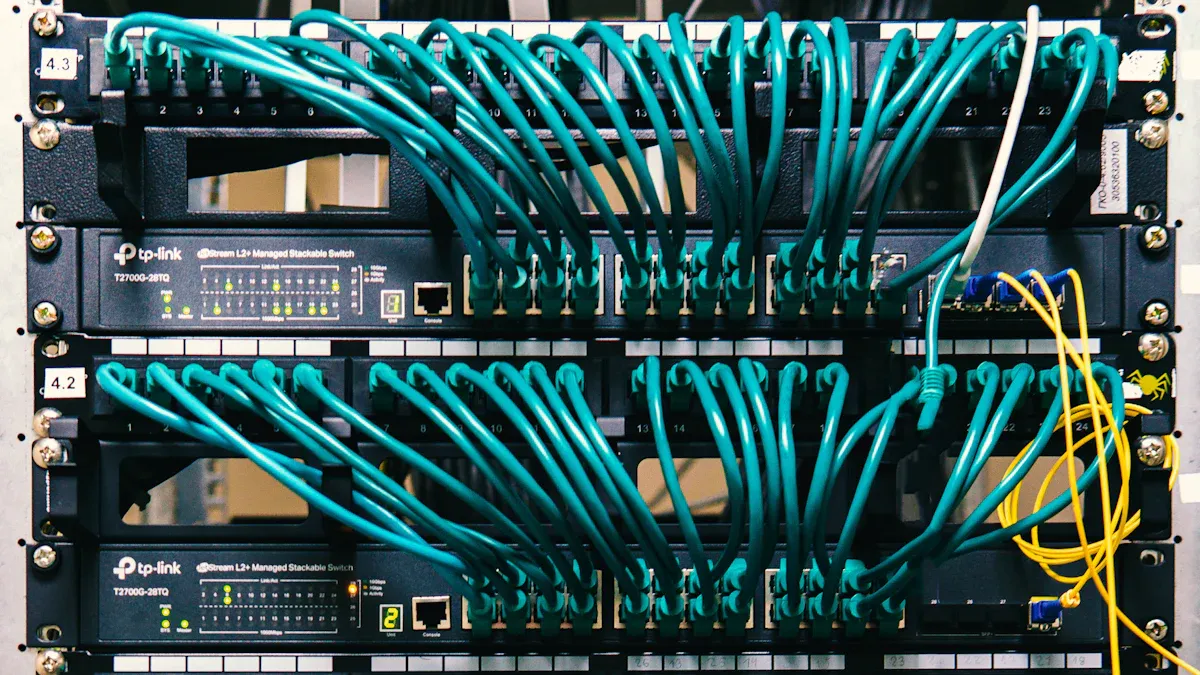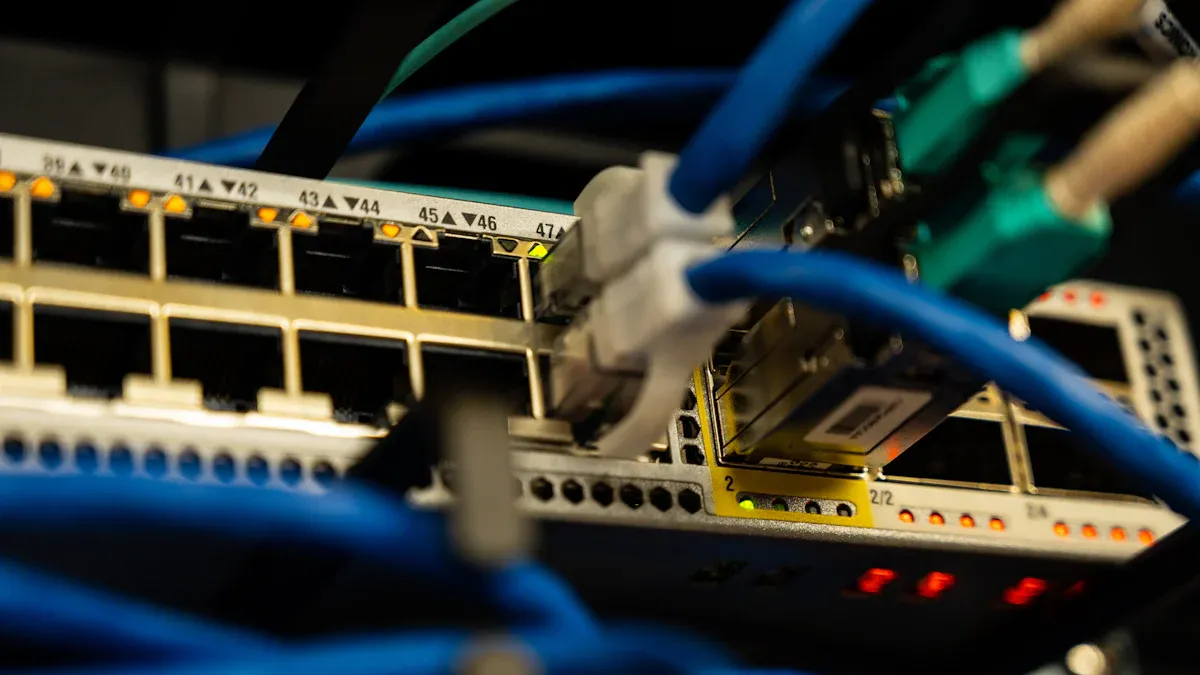
Selecting the right CAT6 PDU cables is crucial for robust network performance. Studies indicate that up to 70% of network performance issues stem from inadequate cabling practices or faulty components. Poor cabling choices, whether for a Basic PDU or an Intelligent PDU, can cause significant financial losses and reduce customer trust. Businesses often face higher maintenance costs and extended downtime when diagnosing issues due to disorganized cables. Understanding essential factors and cable types ensures optimal infrastructure. This approach guarantees optimal network performance and future-proofs your digital environment.
Key Takeaways
- CAT6 PDU cables are important for good network performance. They help manage power in data centers.
- CAT6 cables offer faster speeds and more bandwidth than older CAT5e cables. They support 1 Gigabit Ethernet over 100 meters.
- Choose Unshielded Twisted Pair (UTP) cables for quiet areas. Use Shielded Twisted Pair (STP) cables where there is a lot of electrical noise.
- Solid conductor CAT6 cables work best for long, fixed installations. Stranded cables are good for short, flexible connections like patch cords.
- Cable length affects signal strength. Keep CAT6 runs under 55 meters for 10 Gigabit speeds, or 100 meters for 1 Gigabit speeds.
- Fire safety ratings like CM, CMR, and CMP are important. They tell you where you can safely use the cable.
- Proper installation is key. Avoid tight bends and stress on cables. Ground shielded cables correctly.
- Test and certify CAT6 cables after installation. This makes sure they work well and meet industry rules.
Understanding CAT6 PDU Cables: The Foundation of Your Network

What are CAT6 PDU Cables?
Defining CAT6 for PDU Connectivity
CAT6 cables represent a specific type of twisted-pair cable. They support Gigabit Ethernet and other network protocols. When connected to Power Distribution Units (PDUs), these cables facilitate data communication between network devices and the PDU itself. This connectivity allows for monitoring, management, and control of power distribution within a data center or server rack. A CAT6 PDU connection ensures reliable data flow for critical power infrastructure.
Impact on Network Reliability and Efficiency
The quality of CAT6 PDU cables directly influences network reliability and efficiency. High-quality cables minimize data loss and interference. This ensures accurate and timely communication between network equipment and PDUs. Efficient data transfer prevents bottlenecks and supports consistent network performance, which is vital for critical operations.
Key Characteristics of CAT6 PDU Cables
Bandwidth Capabilities
CAT6 cables offer substantial bandwidth capabilities. They support frequencies up to 250 MHz. This capacity allows for efficient data transmission, accommodating various network demands.
Speed Specifications
CAT6 cables deliver impressive speed specifications. They support 1 Gigabit Ethernet (1 Gbps) over distances up to 100 meters. For shorter runs, specifically up to 55 meters, CAT6 cables can even support 10 Gigabit Ethernet (10 Gbps).
Frequency Range
The operational frequency range for CAT6 cables extends to 250 MHz. This higher frequency range contributes to their superior performance compared to older cable categories.
Distinguishing CAT6 PDU Cables from Other Categories
CAT6 vs. CAT5e Performance Differences
CAT6 cables offer significant performance advantages over CAT5e. CAT6 supports a frequency of 250 MHz, while CAT5e operates at 100 MHz. This difference in frequency range is crucial. CAT6′s thicker gauge and tighter twist effectively reduce interference. CAT6 also exhibits improved return loss, insertion loss, and equal level far-end crosstalk compared to CAT5e. This leads to a higher signal-to-noise ratio.
| Characteristic | Cat5e | Cat6 |
|---|---|---|
| Maximum Frequency | 100 MHz | 250 MHz |
| Maximum Speed (up to 100m) | 1 Gbps | 1 Gbps |
| Maximum Speed (up to 55m) | 1 Gbps | 10 Gbps |
| Suitable for 10GBASE-T | No | Yes (up to 55m) |
| Bandwidth Capacity | Good | Excellent |
CAT6 cables offer lower bit error rates and improved resistance to interference compared to Cat5e. Their tighter twists, often including a spline or separator between pairs, minimize crosstalk. Improved insulation and shielding techniques also contribute to better signal quality. This makes CAT6 more suitable for environments with high electromagnetic interference or where maximum reliability is essential.
CAT6 vs. CAT6a for Future Demands
CAT6a cables represent an advancement over standard CAT6. They offer superior performance for future network demands.
| Feature | Cat6 | Cat6a |
|---|---|---|
| Data Speed | Up to 10 Gbps (55m), 1 Gbps (100m) | Consistent 10 Gbps (100m) |
| Bandwidth | 250 MHz | 500 MHz |
| Shielding | Available in shielded/unshielded, less stringent | Typically shielded, robust performance |
Types of CAT6 PDU Cables: Matching Cable to Need
Different network environments demand specific cable types. Selecting the correct CAT6 PDU cable ensures optimal performance and reliability. Each cable type offers unique characteristics suitable for various applications.
Unshielded Twisted Pair (UTP) CAT6 PDU Cables
UTP CAT6 cables are a common choice for many network installations. They consist of twisted wire pairs without any additional shielding. This design makes them flexible and cost-effective.
Ideal Use Cases for UTP
UTP CAT6 cables are ideal for environments with minimal electromagnetic interference (EMI). Businesses often use them in office settings, residential networks, and small data closets. Their ease of installation makes them suitable for quick deployments where external noise sources are not a significant concern. They perform well in short to medium-distance runs within a controlled environment.
Advantages and Limitations of UTP
UTP cables offer several advantages. They are generally less expensive than shielded alternatives. Their lack of shielding makes them thinner and more flexible, simplifying installation. UTP cables do not require grounding, which further reduces installation complexity. However, UTP cables have limitations. They are susceptible to EMI and radio frequency interference (RFI). This susceptibility can lead to signal degradation in noisy environments. They also offer less security against eavesdropping compared to shielded cables.
Shielded Twisted Pair (STP) CAT6 PDU Cables
STP CAT6 cables incorporate a metallic shield around the twisted wire pairs. This shield provides enhanced protection against external interference.
Enhancing Noise Immunity with STP
STP CAT6 PDU cables achieve enhanced noise immunity through conductive layers (foil or braid) around twisted wire pairs. This shielding reduces electromagnetic interference (EMI) and radio frequency interference (RFI). It also improves crosstalk margin. The shield acts as a continuous conductive path. It diverts RF energy to ground, preventing it from entering the signal pairs. Proper grounding of the shield at both ends, via the RJ45 metal shell and equipment chassis, is crucial for its effectiveness. This grounding serves two purposes: noise diversion, where RF energy shunts to ground, and equipotential safety, ensuring all bonded equipment share the same reference to avoid loop currents. Different shielding constructions offer varying levels of EMI defense.
| Marking | Construction | Shield Path |
|---|---|---|
| UTP | No shield | — |
| F/UTP | Overall foil + drain wire | Foil/drain via RJ45 shell → jack/panel → equipment chassis |
| U/FTP | Foil per pair | Per‑pair foil contacts via shield plug → shield jack |
| S/FTP | Braid overall + foil per pair | Braid + foils bond at plug and chassis |
STP CAT6 PDU cables have an additional layer of foil or braided shielding. This layer encases the twisted wire pairs. This design helps prevent crosstalk between cables. It also mitigates outside interference. This reduces the impact of EMI on network performance.
When to Choose STP for PDU Connections
Organizations should choose STP CAT6 cables for PDU connections in environments with high electromagnetic interference. These environments include data centers, industrial facilities, and areas near heavy machinery. STP cables are also beneficial where data security is a priority. The shielding provides an extra layer of protection against signal interception. Their robust construction ensures reliable data transmission in challenging conditions.
Foil Twisted Pair (FTP) and Screened Unshielded Twisted Pair (S/UTP) CAT6 PDU Cables
FTP and S/UTP cables represent a middle ground between UTP and full STP. They offer a balanced approach to protection.
Balanced Protection with FTP/S/UTP
FTP (Foil Twisted Pair) cables feature an overall foil shield that encases all four twisted pairs. S/UTP (Screened Unshielded Twisted Pair) is another term for this construction. This overall shield provides good protection against external EMI. It also maintains a relatively smaller diameter compared to some heavily shielded STP cables. This design offers a balance between cost, flexibility, and noise immunity. It is more robust than UTP but often less bulky than individually shielded pair cables.
Specific Applications for FTP/S/UTP
FTP/S/UTP CAT6 cables are suitable for environments requiring moderate protection against electromagnetic interference. They effectively mitigate EMI caused by:
- Electromechanical devices.
- Electric motors.
- Transformers.
- Magnets.
- Fluorescent lighting ballast.
These cables are a practical choice for server rooms, wiring closets, and commercial buildings. They provide enhanced performance where some level of interference is present but does not warrant the full shielding of S/FTP cables.
Solid vs. Stranded Conductors in CAT6 PDU Cables
Impact of Solid Conductors on Performance
Solid conductor CAT6 PDU cables use a single, solid wire for each conductor. This construction provides superior electrical performance. Solid conductors offer lower attenuation and better signal integrity over longer distances. They are ideal for permanent installations within walls, conduits, or cable trays. Their rigidity makes them less suitable for frequent movement.
Flexibility and Use Cases for Stranded Conductors
Stranded conductor CAT6 PDU cables consist of multiple thinner wires twisted together to form each conductor. This design makes them highly flexible. Stranded cables are perfect for patch cables, equipment connections, and any application requiring frequent bending or movement. While they offer greater flexibility, stranded conductors have higher attenuation over distance compared to solid conductors. Therefore, they are best for shorter runs, typically within a rack or between a wall plate and a device.
<<<END_SECTION_CONTENT>>>
Solid vs. Stranded Conductors in CAT6 PDU Cables
Network designers must consider the conductor type within CAT6 cables. This choice significantly impacts cable performance and application suitability. CAT6 cables come with either solid or stranded conductors.
Impact of Solid Conductors on Performance
Solid conductor CAT6 cables feature a single, solid wire for each conductor. This construction provides superior electrical performance. Solid conductors offer lower attenuation and better signal integrity over longer distances. They are ideal for permanent installations within walls, conduits, or cable trays. Their rigidity makes them less suitable for frequent movement.
Solid conductors excel in maintaining signal quality. They typically use copper conductors with a gauge between 22AWG and 24AWG. Thicker wires, such as 22AWG, offer lower resistance. This leads to better performance over longer distances. Solid bare copper ensures excellent signal quality and long-lasting performance. The impedance typically measures 100 ohms ±15%. This is crucial for maintaining signal integrity over extended lengths.
Post time: Oct-17-2025

